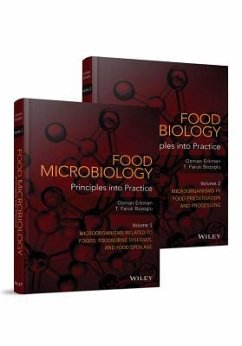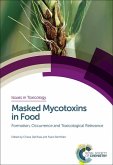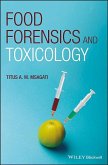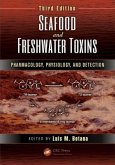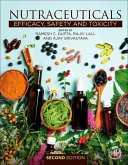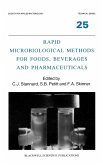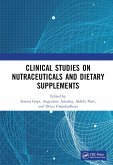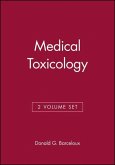- Gebundenes Buch
- Merkliste
- Auf die Merkliste
- Bewerten Bewerten
- Teilen
- Produkt teilen
- Produkterinnerung
- Produkterinnerung
This book covers application of food microbiology principles into food preservation and processing. Main aspects of the food preservation techniques, alternative food preservation techniques, role of microorganisms in food processing and their positive and negative features are covered. Features subjects on mechanism of antimicrobial action of heat, thermal process, mechanisms for microbial control by low temperature, mechanism of food preservation, control of microorganisms and mycotoxin formation by reducing water activity, food preservation by additives and biocontrol, food preservation by…mehr
Andere Kunden interessierten sich auch für
![Masked Mycotoxins in Food Masked Mycotoxins in Food]() Masked Mycotoxins in Food217,99 €
Masked Mycotoxins in Food217,99 €![Food Forensics and Toxicology Food Forensics and Toxicology]() Titus A M MsagatiFood Forensics and Toxicology239,99 €
Titus A M MsagatiFood Forensics and Toxicology239,99 €![Seafood and Freshwater Toxins Seafood and Freshwater Toxins]() Seafood and Freshwater Toxins503,99 €
Seafood and Freshwater Toxins503,99 €![Nutraceuticals Nutraceuticals]() Nutraceuticals216,99 €
Nutraceuticals216,99 €![Rapid Microbiological Methods for Foods, Beverages and Pharmaceuticals Rapid Microbiological Methods for Foods, Beverages and Pharmaceuticals]() Rapid Microbiological Methods for Foods, Beverages and Pharmaceuticals182,99 €
Rapid Microbiological Methods for Foods, Beverages and Pharmaceuticals182,99 €![Clinical Studies on Nutraceuticals and Dietary Supplements Clinical Studies on Nutraceuticals and Dietary Supplements]() Clinical Studies on Nutraceuticals and Dietary Supplements152,99 €
Clinical Studies on Nutraceuticals and Dietary Supplements152,99 €![Medical Toxicology, 2 Volume Set Medical Toxicology, 2 Volume Set]() Donald G. BarcelouxMedical Toxicology, 2 Volume Set443,99 €
Donald G. BarcelouxMedical Toxicology, 2 Volume Set443,99 €-
-
-
This book covers application of food microbiology principles into food preservation and processing. Main aspects of the food preservation techniques, alternative food preservation techniques, role of microorganisms in food processing and their positive and negative features are covered. Features subjects on mechanism of antimicrobial action of heat, thermal process, mechanisms for microbial control by low temperature, mechanism of food preservation, control of microorganisms and mycotoxin formation by reducing water activity, food preservation by additives and biocontrol, food preservation by modified atmosphere, alternative food processing techniques, and traditional fermented products processing. The book is designed for students in food engineering, health science, food science, agricultural engineering, food technology, nutrition and dietetic, biological sciences and biotechnology fields. It will also be valuable to researchers, teachers and practising food microbiologists as well as anyone interested in different branches of food.
Hinweis: Dieser Artikel kann nur an eine deutsche Lieferadresse ausgeliefert werden.
Hinweis: Dieser Artikel kann nur an eine deutsche Lieferadresse ausgeliefert werden.
Produktdetails
- Produktdetails
- Verlag: Wiley
- Seitenzahl: 944
- Erscheinungstermin: 13. Juni 2016
- Englisch
- Abmessung: 251mm x 170mm x 46mm
- Gewicht: 1905g
- ISBN-13: 9781119237761
- ISBN-10: 1119237769
- Artikelnr.: 44694593
- Verlag: Wiley
- Seitenzahl: 944
- Erscheinungstermin: 13. Juni 2016
- Englisch
- Abmessung: 251mm x 170mm x 46mm
- Gewicht: 1905g
- ISBN-13: 9781119237761
- ISBN-10: 1119237769
- Artikelnr.: 44694593
Professor Dr. Osman Erkmen, Department of Food Engineering, Faculty of Engineering, University of Gaziantep, Turkey. Professor Dr. T. Faruk Bozoglu, Department of Food Engineering, Faculty of Engineering, Middle East Technical University, Turkey.
About the Authors
xv Preface
xvii Section I: Microbiology and Microbial Behavior in Foods
1 1 History and Development of Food Microbiology
3 1.1 Introduction
3 1.2 History of Microorganisms in Foods
4 1.2.1 Early Development on Foods
4 1.2.2 Discovery of Microorganisms
4 1.2.3 Development of Food Microbiology
5 1.2.4 Modern Microbiology
6 1.3 Fields of Food Microbiology
7 1.3.1 Importance of Microorganisms in Foods
7 1.3.2 Food Microbiology Course
12 2 Microbial Growth in Foods
13 2.1 Introduction
13 2.2 General Principles of Microbial Growth
13 2.2.1 Importance Being Small Size
13 2.2.2 Microbial Reproduction
14 2.2.3 Growth and Death
16 2.2.4 Predictive Microbiology
21 2.2.5 Relationships Among Microorganisms in Foods
31 2.2.6 Type and Number of Microorganisms in Foods
34 3 Types of Microorganisms in Foods
35 3.1 Introduction
35 3.2 Nomenclature of Microorganisms
35 3.3 Microorganisms in Foods
36 3.3.1 Bacteria
36 3.3.2 Fungi
51 3.3.3 Viruses and Other Agents
66 3.3.4 Parasites
67 3.3.5 Algae
68 3.4 Microbial Genetics
68 3.4.1 Characteristics of Microbial Genetics
68 3.4.2 Genetic Recombination
69 3.4.3 Extrachromosomal Genes
72 3.4.4 Genetic Mechanism of Drug Resistance
73 3.5 Significance of Microorganisms in Foods
74 3.5.1 Cereals
Starches
and Gums
74 3.5.2 Canned Foods
75 3.5.3 Eggs
75 3.5.4 Fish and Shellfish
76 3.5.5 Mayonnaise and Salad Dressings
76 3.5.6 Raw and Pasteurized Milk
76 3.5.7 Raw and Ready-to-Eat Meat Products
77 3.5.8 Vegetables
Fruits
and Nuts
78 3.5.9 Soft Drinks
Fruit and Vegetable Drinks
and Bottled Water
79 3.5.10 Spices
79 3.5.11 Sugars and Confectionaries
80 Section II: Microbial Sources and Factors Affecting Microorganisms
81 4 Presources of Microorganisms in Foods
83 4.1 Introduction
83 4.2 Primary Sources of Microorganisms Present in Foods
83 4.2.1 Water
84 4.2.2 Plants and Plant Products
85 4.2.3 Food Equipment and Packaging Material
85 4.2.4 Intestinal Tract of Man and Animals
86 4.2.5 Food Handlers
86 4.2.6 Food Ingredients
86 4.2.7 Animals
Birds
and Fish
87 4.2.8 Sewage
88 4.2.9 Air
Dust
and Soil
88 4.2.10 Improper Handling Procedures
89 4.2.11 Miscellaneous Sources
90 5 Factors Affecting Microbial Growth in Foods
91 5.1 Introduction
91 5.2 Intrinsic Factors
91 5.2.1 pH
91 5.2.2 Water Activity
94 5.2.3 Oxidation-Reduction Potential
97 5.2.4 Nutrient Content
100 5.2.5 Antimicrobial Content
101 5.2.6 Biological Protective Structure
102 5.3 Extrinsic Factors
102 5.3.1 Temperature
102 5.3.2 Relative Humidity
104 5.3.3 Gaseous Atmosphere
105 5.3.4 Presence of Other Microorganisms
105 Section III: Foodborne Diseases
107 6 Important Factors in Foodborne Diseases
109 6.1 Introduction
109 6.2 Important Facts in Foodborne Diseases
110 6.2.1 Side Effects of Foodborne Diseases
110 6.2.2 Investigation of Foodborne Diseases
111 6.2.3 Importance of Foodborne Diseases
112 6.2.4 Susceptibility to Foodborne Diseases
114 6.2.5 Types of Foodborne Diseases
114 6.3 Immune Responses
117 6.3.1 Interactions Between Immune System and Microorganisms
118 6.3.2 Immune Systems
119 6.3.3 Types of Immune Systems
119 7 Bacterial Pathogenicity and Microbial Toxins
126 7.1 Introduction
126 7.2 Bacterial Pathogenicity
127 7.2.1 Mechanisms of Bacterial Pathogenicity
127 7.2.2 Virulence Factors
128 7.3 Bacterial Toxins
131 7.3.1 Types of Bacterial Toxins
131 7.3.2 Pathogenicity of Bacterial Structure
135 7.3.3 Enteric Bacterial Toxins
136 8 Foodborne Invasive Infections
138 8.1 Introduction
138 8.2 Types of Foodborne Invasive Infection
139 8.2.1 Brucella (Brucellosis)
139 8.2.2 Campylobacter (Campylobacteriosis)
141 8.2.3 Pathogenic Escherichia coli Group
145 8.2.4 Listeria monocytogenes (Listeriosis)
151 8.2.5 Salmonella (Salmonellosis)
154 8.2.6 Shigella (Shigellosis)
158 8.2.7 Vibrio (Vibriosis)
161 8.2.8 Yersinia enterocolitica (Yersiniosis)
164 8.2.9 Infections with Other Bacteria
166 9 Foodborne Toxicoinfections
171 9.1 Introduction
171 9.2 Types of Foodborne Toxicoinfection
171 9.2.1 A. hydrophila
171 9.2.2 B. cereus (Diarrheal Syndrome)
173 9.2.3 C. perfringens
176 9.2.4 P. shigelloides
180 9.2.5 V. cholerae
181 9.2.6 Enterotoxigenic and Enteropathogenic E. coli
184 10 Foodborne Intoxications
186 10.1 Introduction
186 10.2 Bacterial Foodborne Intoxication
186 10.2.1 B. cereus (Emetic Poisoning)
186 10.2.2 Staphylococcus aureus (Staphylococcal Poisoning)
187 10.2.3 Clostridium botulinum (Botulism)
190 10.3 Mycotoxins
193 10.3.1 Characteristics of Mycotoxin-Producing Molds
193 10.3.2 Contamination of Foods by Mycotoxins
194 10.3.3 Major Types of Mycotoxins
195 10.3.4 Stability of Mycotoxins in Foods
201 10.4 Mushroom Toxins
202 10.4.1 Protoplasmic Toxins
203 10.4.2 Neurotoxins
204 10.4.3 Gastrointestinal Irritants
205 10.4.4 Disulfiram-Like Poisoning
205 10.4.5 Other Mushroom Poisonings
205 10.5 Biogenic Amines
205 10.5.1 Occurrence of Biogenic Amines in Foods
206 10.5.2 Biogenic Amine Poisoning
206 10.5.3 Prevention and Control
207 11 Parasites
Marine Toxins
and Virus Food Poisonings
208 11.1 Introduction
208 11.2 Parasites
208 11.2.1 Helminths
209 11.2.2 Protozoa
212 11.2.3 Occurrence of Parasites in Foods and Water
214 11.3 Marine Toxins
215 11.3.1 Types of Marine Poisonings
215 11.3.2 Prevention of Marine Poisonings
217 11.4 Chemical Poisoning
217 11.5 Foodborne Viruses and Prion
218 11.5.1 Characteristics of Viruses
218 11.5.2 Important Viruses
218 11.5.3 Spongiform Encephalopathies
220 11.6 Food Allergy
221 12 Indicators of Foodborne Pathogens
223 12.1 Introduction
223 12.2 Establishment of Microbiological Criteria
223 12.3 Indicators of Pathogens in Foods
225 12.3.1 Coliforms
226 12.3.2 Fecal Coliforms
227 12.3.3 E. coli
228 12.3.4 Enterobacteriaceae
228 12.3.5 Enterococcus
229 12.3.6 Total Viable Count
229 12.3.7 Other Microbial Indicators
230 Section IV: Detection of Microorganisms
231 13 Conventional Techniques in Food Microbiology
233 13.1 Introduction
233 13.2 Sampling Plan and Sample Preparation
233 13.2.1 Sampling Plan
233 13.2.2 Sample Preparation
235 13.3 Conventional Microbial Counting Methods
237 13.3.1 Quantitative Methods
237 13.3.2 Qualitative Methods
243 14 Advanced Techniques in Food Microbiology
245 14.1 Introduction
245 14.2 Developing Rapid Methods
246 14.2.1 Microbiological Testing of Foods
246 14.2.2 Problems in Food Analysis
246 14.2.3 Development and Origin of Rapid Methods
247 14.3 Physical Methods
248 14.3.1 Impedance Method
248 14.3.2 Microcalorimetry
250 14.3.3 Particle Counting
250 14.3.4 Bacteriophage
251 14.3.5 Image Analysis Systems
251 14.3.6 Chromatographic Method
251 14.3.7 Electrophoresis
251 14.3.8 Detection of Microorganisms by Infrared Detectors
252 14.4 Chemical Methods
253 14.4.1 Radiometry (Isotopic Method)
253 14.4.2 Bioluminescence
254 14.4.3 Thermostable Nuclease
255 14.4.4 Nucleic Acid Probes and PCR Methods
255 14.4.5 Glucuronidase Assay for E. coli
257 14.4.6 Limulus Amoebocyte Lysate Test
258 14.5 Immunoassay Methods
258 14.5.1 Radioimmunoassay
258 14.5.2 Enzyme-Linked Immunosorbent Assay
259 14.5.3 Immunofluorescence Antibody
259 14.5.4 Immunomagnetic Separation
260 14.5.5 Latex Agglutination
260 14.5.6 Enrichment Serology
261 14.5.7 Immunoelectron Microscopy
261 14.5.8 Precipitin Reaction
261 14.5.9 Agglutination Tests
262 14.5.10 Immunoelectrophoresis
262 14.6 Other Methods
263 14.7 Limitation of Rapid Methods
263 14.8 Future Developments in Rapid Methods
264 14.8.1 Immunosensors or Biosensors
264 14.8.2 DNA Microarrays (Chips)
265 Section V: Microbial Food Spoilage
267 15 Principles of Food Spoilage
269 15.1 Introduction
269 15.2 Food Spoilage
269 15.2.1 Acceptable Foods
269 15.2.2 Classification of Foods Depending on Stability
270 15.2.3 Types of Agents Causing Food Spoilage
271 15.2.4 Types of Food Spoilage
271 15.2.5 Factors Affecting Food Spoilage
275 16 Spoilage of Meat and Meat Products
279 16.1 Introduction
279 16.2 Meat and Meat Products
279 16.2.1 Bacterial Attachment with Meat
279 16.2.2 Contamination
280 16.2.3 Meat Spoilage
282 16.2.4 Meat Products
287 16.2.5 Preservation of Meat and Meat Products
291 16.3 Poultry
293 16.3.1 Contamination
293 16.3.2 Spoilage
294 16.3.3 Preservation of Poultry
294 17 Spoilage of Eggs and Egg Products
296 17.1 Introduction
296 17.2 Microbial Contamination
296 17.3 Spoilage
297 17.3.1 Nonmicrobial Spoilage
297 17.3.2 Microbial Spoilage
297 17.4 Preservation of Eggs and Egg Products
298 17.4.1 Asepsis
298 17.4.2 Removal of Microorganisms
299 17.4.3 Use of Heat Treatment
299 17.4.4 Use of Low Temperatures
299 17.4.5 Use of Preservatives
300 18 Spoilage of Fish and Other Seafoods
301 18.1 Introduction
301 18.2 Microbial Contamination
301 18.3 Spoilage
302 18.3.1 Fish
302 18.3.2 Shellfish
304 18.4 Preservation of Fish and Other Seafoods
304 19 Spoilage of Milk and Milk Products
307 19.1 Introduction
307 19.2 Milk Composition and Microbial Contamination
307 19.3 Spoilage
309 19.3.1 Raw Milk Spoilage
309 19.3.2 Fluid Milk Products Spoilage
315 19.3.3 Fermented Milk Products Spoilage
322 19.4 Preservation of Milk and Milk Products
332 19.4.1 Asepsis
332 19.4.2 Removal of Microorganisms
333 19.4.3 Use of Heat
333 19.4.4 Low Temperature
334 19.4.5 Drying
334 19.4.6 Use of Preservatives
335 19.4.7 Mechanical Reduction of Microorganisms
336 20 Spoilage of Vegetables and Fruits
337 20.1 Introduction
337 20.2 Vegetables and Fruits Spoilage
338 20.2.1 Natural Microflora
338 20.2.2 Mechanisms of Microbial Spoilage
338 20.2.3 Vegetables Spoilage
340 20.2.4 Fruits Spoilage
343 20.2.5 Preservation of Vegetables and Fruits
347 20.3 Fruit Juice and Beverage Spoilage
349 20.3.1 Spoilage
349 20.3.2 Pathogens
353 20.4 Fermented Vegetables and Fruits Spoilage
354 20.4.1 Sauerkraut Spoilage
355 20.4.2 Pickle Spoilage
356 20.4.3 Table Olive Spoilage
358 20.4.4 Alcoholic Beverage Spoilage
361 21 Spoilage of Cereals and Cereal Products
364 21.1 Introduction
364 21.2 Contamination
364 21.3 Spoilage
365 21.3.1 Cereal Grains Spoilage
365 21.3.2 Flour Spoilage
368 21.3.3 Bread Spoilage
368 21.3.4 Pastas Spoilage
371 21.3.5 Pastries Spoilage
371 21.4 Control of Mold and Mycotoxin Contamination
371 21.4.1 Control of Mold Growth
372 21.4.2 Prevention of Mold and Mycotoxin Contamination
373 21.4.3 Decontamination of Mycotoxins
374 22 Spoilage of Canned Foods
376 22.1 Introduction
376 22.2 Canned Foods
376 22.2.1 Classification of Canned Foods Based on Acidity
376 22.2.2 Commercial Sterility of Canned Foods
377 22.3 Canned Food Spoilage
377 22.3.1 Microbial Spoilage
378 22.3.2 Chemical Spoilage
383 22.3.3 Appearance of Unopened Cans
383 23 Spoilage of Miscellaneous Foods
385 23.1 Introduction
385 23.2 Spoilage
385 23.2.1 Spoilage of Sugar and Honey
385 23.2.2 Spoilage of Spices
Seasonings
and Dry Soups
390 23.2.3 Spoilage of Cocoa
Chocolate
and Confectionery
391 23.2.4 Spoilage of Oil- and Fat-Based Products
393 23.2.5 Drinking Water
399 24 Enzymatic and Nonenzymatic Food Spoilage
401 24.1 Introduction
401 24.2 Spoilage
401 24.2.1 Nonenzymatic Spoilage
401 24.2.2 Enzymatic Spoilage
402 24.2.3 Characteristics of Heat-Stable Enzymes of Psychrotrophs
404 24.2.4 Spoilage of Foods by Heat-Stable Microbial Enzymes
404 24.2.5 Inhibition of Enzymes
406 25 Indicators of Food Spoilage
407 25.1 Introduction
407 25.2 Indicators of Food Spoilage
407 25.2.1 Food Spoilage Criteria
407 25.2.2 Indicators of Microbial Spoilage Criteria
408 25.2.3 Heat-Stable Enzymes as Spoilage Criteria
412 26 Psychrotrophs
Thermophiles
and Radiation-Resistant Microorganisms
413 26.1 Introduction
413 26.2 Psychrotrophic Microorganisms
413 26.2.1 Temperature-Induced Changes
414 26.2.2 Effect of Low Temperatures on Microbial Physiology
414 26.2.3 Nature of Low Heat Resistance of Psychrotrophs
415 26.3 Thermophilic Microorganisms
416 26.3.1 Thermostability
416 26.3.2 Factors Affecting Thermophilic Microorganisms
416 26.4 Radiation-Resistant Microorganisms
417 26.4.1 Characteristics of Radiation-Resistant Micrococcus
417 26.4.2 Mechanism of Microbial Radiation Resistance
418 26.4.3 Factors Affecting Radiation Resistance
418 Bibliography
419 Index
431
xv Preface
xvii Section I: Microbiology and Microbial Behavior in Foods
1 1 History and Development of Food Microbiology
3 1.1 Introduction
3 1.2 History of Microorganisms in Foods
4 1.2.1 Early Development on Foods
4 1.2.2 Discovery of Microorganisms
4 1.2.3 Development of Food Microbiology
5 1.2.4 Modern Microbiology
6 1.3 Fields of Food Microbiology
7 1.3.1 Importance of Microorganisms in Foods
7 1.3.2 Food Microbiology Course
12 2 Microbial Growth in Foods
13 2.1 Introduction
13 2.2 General Principles of Microbial Growth
13 2.2.1 Importance Being Small Size
13 2.2.2 Microbial Reproduction
14 2.2.3 Growth and Death
16 2.2.4 Predictive Microbiology
21 2.2.5 Relationships Among Microorganisms in Foods
31 2.2.6 Type and Number of Microorganisms in Foods
34 3 Types of Microorganisms in Foods
35 3.1 Introduction
35 3.2 Nomenclature of Microorganisms
35 3.3 Microorganisms in Foods
36 3.3.1 Bacteria
36 3.3.2 Fungi
51 3.3.3 Viruses and Other Agents
66 3.3.4 Parasites
67 3.3.5 Algae
68 3.4 Microbial Genetics
68 3.4.1 Characteristics of Microbial Genetics
68 3.4.2 Genetic Recombination
69 3.4.3 Extrachromosomal Genes
72 3.4.4 Genetic Mechanism of Drug Resistance
73 3.5 Significance of Microorganisms in Foods
74 3.5.1 Cereals
Starches
and Gums
74 3.5.2 Canned Foods
75 3.5.3 Eggs
75 3.5.4 Fish and Shellfish
76 3.5.5 Mayonnaise and Salad Dressings
76 3.5.6 Raw and Pasteurized Milk
76 3.5.7 Raw and Ready-to-Eat Meat Products
77 3.5.8 Vegetables
Fruits
and Nuts
78 3.5.9 Soft Drinks
Fruit and Vegetable Drinks
and Bottled Water
79 3.5.10 Spices
79 3.5.11 Sugars and Confectionaries
80 Section II: Microbial Sources and Factors Affecting Microorganisms
81 4 Presources of Microorganisms in Foods
83 4.1 Introduction
83 4.2 Primary Sources of Microorganisms Present in Foods
83 4.2.1 Water
84 4.2.2 Plants and Plant Products
85 4.2.3 Food Equipment and Packaging Material
85 4.2.4 Intestinal Tract of Man and Animals
86 4.2.5 Food Handlers
86 4.2.6 Food Ingredients
86 4.2.7 Animals
Birds
and Fish
87 4.2.8 Sewage
88 4.2.9 Air
Dust
and Soil
88 4.2.10 Improper Handling Procedures
89 4.2.11 Miscellaneous Sources
90 5 Factors Affecting Microbial Growth in Foods
91 5.1 Introduction
91 5.2 Intrinsic Factors
91 5.2.1 pH
91 5.2.2 Water Activity
94 5.2.3 Oxidation-Reduction Potential
97 5.2.4 Nutrient Content
100 5.2.5 Antimicrobial Content
101 5.2.6 Biological Protective Structure
102 5.3 Extrinsic Factors
102 5.3.1 Temperature
102 5.3.2 Relative Humidity
104 5.3.3 Gaseous Atmosphere
105 5.3.4 Presence of Other Microorganisms
105 Section III: Foodborne Diseases
107 6 Important Factors in Foodborne Diseases
109 6.1 Introduction
109 6.2 Important Facts in Foodborne Diseases
110 6.2.1 Side Effects of Foodborne Diseases
110 6.2.2 Investigation of Foodborne Diseases
111 6.2.3 Importance of Foodborne Diseases
112 6.2.4 Susceptibility to Foodborne Diseases
114 6.2.5 Types of Foodborne Diseases
114 6.3 Immune Responses
117 6.3.1 Interactions Between Immune System and Microorganisms
118 6.3.2 Immune Systems
119 6.3.3 Types of Immune Systems
119 7 Bacterial Pathogenicity and Microbial Toxins
126 7.1 Introduction
126 7.2 Bacterial Pathogenicity
127 7.2.1 Mechanisms of Bacterial Pathogenicity
127 7.2.2 Virulence Factors
128 7.3 Bacterial Toxins
131 7.3.1 Types of Bacterial Toxins
131 7.3.2 Pathogenicity of Bacterial Structure
135 7.3.3 Enteric Bacterial Toxins
136 8 Foodborne Invasive Infections
138 8.1 Introduction
138 8.2 Types of Foodborne Invasive Infection
139 8.2.1 Brucella (Brucellosis)
139 8.2.2 Campylobacter (Campylobacteriosis)
141 8.2.3 Pathogenic Escherichia coli Group
145 8.2.4 Listeria monocytogenes (Listeriosis)
151 8.2.5 Salmonella (Salmonellosis)
154 8.2.6 Shigella (Shigellosis)
158 8.2.7 Vibrio (Vibriosis)
161 8.2.8 Yersinia enterocolitica (Yersiniosis)
164 8.2.9 Infections with Other Bacteria
166 9 Foodborne Toxicoinfections
171 9.1 Introduction
171 9.2 Types of Foodborne Toxicoinfection
171 9.2.1 A. hydrophila
171 9.2.2 B. cereus (Diarrheal Syndrome)
173 9.2.3 C. perfringens
176 9.2.4 P. shigelloides
180 9.2.5 V. cholerae
181 9.2.6 Enterotoxigenic and Enteropathogenic E. coli
184 10 Foodborne Intoxications
186 10.1 Introduction
186 10.2 Bacterial Foodborne Intoxication
186 10.2.1 B. cereus (Emetic Poisoning)
186 10.2.2 Staphylococcus aureus (Staphylococcal Poisoning)
187 10.2.3 Clostridium botulinum (Botulism)
190 10.3 Mycotoxins
193 10.3.1 Characteristics of Mycotoxin-Producing Molds
193 10.3.2 Contamination of Foods by Mycotoxins
194 10.3.3 Major Types of Mycotoxins
195 10.3.4 Stability of Mycotoxins in Foods
201 10.4 Mushroom Toxins
202 10.4.1 Protoplasmic Toxins
203 10.4.2 Neurotoxins
204 10.4.3 Gastrointestinal Irritants
205 10.4.4 Disulfiram-Like Poisoning
205 10.4.5 Other Mushroom Poisonings
205 10.5 Biogenic Amines
205 10.5.1 Occurrence of Biogenic Amines in Foods
206 10.5.2 Biogenic Amine Poisoning
206 10.5.3 Prevention and Control
207 11 Parasites
Marine Toxins
and Virus Food Poisonings
208 11.1 Introduction
208 11.2 Parasites
208 11.2.1 Helminths
209 11.2.2 Protozoa
212 11.2.3 Occurrence of Parasites in Foods and Water
214 11.3 Marine Toxins
215 11.3.1 Types of Marine Poisonings
215 11.3.2 Prevention of Marine Poisonings
217 11.4 Chemical Poisoning
217 11.5 Foodborne Viruses and Prion
218 11.5.1 Characteristics of Viruses
218 11.5.2 Important Viruses
218 11.5.3 Spongiform Encephalopathies
220 11.6 Food Allergy
221 12 Indicators of Foodborne Pathogens
223 12.1 Introduction
223 12.2 Establishment of Microbiological Criteria
223 12.3 Indicators of Pathogens in Foods
225 12.3.1 Coliforms
226 12.3.2 Fecal Coliforms
227 12.3.3 E. coli
228 12.3.4 Enterobacteriaceae
228 12.3.5 Enterococcus
229 12.3.6 Total Viable Count
229 12.3.7 Other Microbial Indicators
230 Section IV: Detection of Microorganisms
231 13 Conventional Techniques in Food Microbiology
233 13.1 Introduction
233 13.2 Sampling Plan and Sample Preparation
233 13.2.1 Sampling Plan
233 13.2.2 Sample Preparation
235 13.3 Conventional Microbial Counting Methods
237 13.3.1 Quantitative Methods
237 13.3.2 Qualitative Methods
243 14 Advanced Techniques in Food Microbiology
245 14.1 Introduction
245 14.2 Developing Rapid Methods
246 14.2.1 Microbiological Testing of Foods
246 14.2.2 Problems in Food Analysis
246 14.2.3 Development and Origin of Rapid Methods
247 14.3 Physical Methods
248 14.3.1 Impedance Method
248 14.3.2 Microcalorimetry
250 14.3.3 Particle Counting
250 14.3.4 Bacteriophage
251 14.3.5 Image Analysis Systems
251 14.3.6 Chromatographic Method
251 14.3.7 Electrophoresis
251 14.3.8 Detection of Microorganisms by Infrared Detectors
252 14.4 Chemical Methods
253 14.4.1 Radiometry (Isotopic Method)
253 14.4.2 Bioluminescence
254 14.4.3 Thermostable Nuclease
255 14.4.4 Nucleic Acid Probes and PCR Methods
255 14.4.5 Glucuronidase Assay for E. coli
257 14.4.6 Limulus Amoebocyte Lysate Test
258 14.5 Immunoassay Methods
258 14.5.1 Radioimmunoassay
258 14.5.2 Enzyme-Linked Immunosorbent Assay
259 14.5.3 Immunofluorescence Antibody
259 14.5.4 Immunomagnetic Separation
260 14.5.5 Latex Agglutination
260 14.5.6 Enrichment Serology
261 14.5.7 Immunoelectron Microscopy
261 14.5.8 Precipitin Reaction
261 14.5.9 Agglutination Tests
262 14.5.10 Immunoelectrophoresis
262 14.6 Other Methods
263 14.7 Limitation of Rapid Methods
263 14.8 Future Developments in Rapid Methods
264 14.8.1 Immunosensors or Biosensors
264 14.8.2 DNA Microarrays (Chips)
265 Section V: Microbial Food Spoilage
267 15 Principles of Food Spoilage
269 15.1 Introduction
269 15.2 Food Spoilage
269 15.2.1 Acceptable Foods
269 15.2.2 Classification of Foods Depending on Stability
270 15.2.3 Types of Agents Causing Food Spoilage
271 15.2.4 Types of Food Spoilage
271 15.2.5 Factors Affecting Food Spoilage
275 16 Spoilage of Meat and Meat Products
279 16.1 Introduction
279 16.2 Meat and Meat Products
279 16.2.1 Bacterial Attachment with Meat
279 16.2.2 Contamination
280 16.2.3 Meat Spoilage
282 16.2.4 Meat Products
287 16.2.5 Preservation of Meat and Meat Products
291 16.3 Poultry
293 16.3.1 Contamination
293 16.3.2 Spoilage
294 16.3.3 Preservation of Poultry
294 17 Spoilage of Eggs and Egg Products
296 17.1 Introduction
296 17.2 Microbial Contamination
296 17.3 Spoilage
297 17.3.1 Nonmicrobial Spoilage
297 17.3.2 Microbial Spoilage
297 17.4 Preservation of Eggs and Egg Products
298 17.4.1 Asepsis
298 17.4.2 Removal of Microorganisms
299 17.4.3 Use of Heat Treatment
299 17.4.4 Use of Low Temperatures
299 17.4.5 Use of Preservatives
300 18 Spoilage of Fish and Other Seafoods
301 18.1 Introduction
301 18.2 Microbial Contamination
301 18.3 Spoilage
302 18.3.1 Fish
302 18.3.2 Shellfish
304 18.4 Preservation of Fish and Other Seafoods
304 19 Spoilage of Milk and Milk Products
307 19.1 Introduction
307 19.2 Milk Composition and Microbial Contamination
307 19.3 Spoilage
309 19.3.1 Raw Milk Spoilage
309 19.3.2 Fluid Milk Products Spoilage
315 19.3.3 Fermented Milk Products Spoilage
322 19.4 Preservation of Milk and Milk Products
332 19.4.1 Asepsis
332 19.4.2 Removal of Microorganisms
333 19.4.3 Use of Heat
333 19.4.4 Low Temperature
334 19.4.5 Drying
334 19.4.6 Use of Preservatives
335 19.4.7 Mechanical Reduction of Microorganisms
336 20 Spoilage of Vegetables and Fruits
337 20.1 Introduction
337 20.2 Vegetables and Fruits Spoilage
338 20.2.1 Natural Microflora
338 20.2.2 Mechanisms of Microbial Spoilage
338 20.2.3 Vegetables Spoilage
340 20.2.4 Fruits Spoilage
343 20.2.5 Preservation of Vegetables and Fruits
347 20.3 Fruit Juice and Beverage Spoilage
349 20.3.1 Spoilage
349 20.3.2 Pathogens
353 20.4 Fermented Vegetables and Fruits Spoilage
354 20.4.1 Sauerkraut Spoilage
355 20.4.2 Pickle Spoilage
356 20.4.3 Table Olive Spoilage
358 20.4.4 Alcoholic Beverage Spoilage
361 21 Spoilage of Cereals and Cereal Products
364 21.1 Introduction
364 21.2 Contamination
364 21.3 Spoilage
365 21.3.1 Cereal Grains Spoilage
365 21.3.2 Flour Spoilage
368 21.3.3 Bread Spoilage
368 21.3.4 Pastas Spoilage
371 21.3.5 Pastries Spoilage
371 21.4 Control of Mold and Mycotoxin Contamination
371 21.4.1 Control of Mold Growth
372 21.4.2 Prevention of Mold and Mycotoxin Contamination
373 21.4.3 Decontamination of Mycotoxins
374 22 Spoilage of Canned Foods
376 22.1 Introduction
376 22.2 Canned Foods
376 22.2.1 Classification of Canned Foods Based on Acidity
376 22.2.2 Commercial Sterility of Canned Foods
377 22.3 Canned Food Spoilage
377 22.3.1 Microbial Spoilage
378 22.3.2 Chemical Spoilage
383 22.3.3 Appearance of Unopened Cans
383 23 Spoilage of Miscellaneous Foods
385 23.1 Introduction
385 23.2 Spoilage
385 23.2.1 Spoilage of Sugar and Honey
385 23.2.2 Spoilage of Spices
Seasonings
and Dry Soups
390 23.2.3 Spoilage of Cocoa
Chocolate
and Confectionery
391 23.2.4 Spoilage of Oil- and Fat-Based Products
393 23.2.5 Drinking Water
399 24 Enzymatic and Nonenzymatic Food Spoilage
401 24.1 Introduction
401 24.2 Spoilage
401 24.2.1 Nonenzymatic Spoilage
401 24.2.2 Enzymatic Spoilage
402 24.2.3 Characteristics of Heat-Stable Enzymes of Psychrotrophs
404 24.2.4 Spoilage of Foods by Heat-Stable Microbial Enzymes
404 24.2.5 Inhibition of Enzymes
406 25 Indicators of Food Spoilage
407 25.1 Introduction
407 25.2 Indicators of Food Spoilage
407 25.2.1 Food Spoilage Criteria
407 25.2.2 Indicators of Microbial Spoilage Criteria
408 25.2.3 Heat-Stable Enzymes as Spoilage Criteria
412 26 Psychrotrophs
Thermophiles
and Radiation-Resistant Microorganisms
413 26.1 Introduction
413 26.2 Psychrotrophic Microorganisms
413 26.2.1 Temperature-Induced Changes
414 26.2.2 Effect of Low Temperatures on Microbial Physiology
414 26.2.3 Nature of Low Heat Resistance of Psychrotrophs
415 26.3 Thermophilic Microorganisms
416 26.3.1 Thermostability
416 26.3.2 Factors Affecting Thermophilic Microorganisms
416 26.4 Radiation-Resistant Microorganisms
417 26.4.1 Characteristics of Radiation-Resistant Micrococcus
417 26.4.2 Mechanism of Microbial Radiation Resistance
418 26.4.3 Factors Affecting Radiation Resistance
418 Bibliography
419 Index
431
About the Authors
xv Preface
xvii Section I: Microbiology and Microbial Behavior in Foods
1 1 History and Development of Food Microbiology
3 1.1 Introduction
3 1.2 History of Microorganisms in Foods
4 1.2.1 Early Development on Foods
4 1.2.2 Discovery of Microorganisms
4 1.2.3 Development of Food Microbiology
5 1.2.4 Modern Microbiology
6 1.3 Fields of Food Microbiology
7 1.3.1 Importance of Microorganisms in Foods
7 1.3.2 Food Microbiology Course
12 2 Microbial Growth in Foods
13 2.1 Introduction
13 2.2 General Principles of Microbial Growth
13 2.2.1 Importance Being Small Size
13 2.2.2 Microbial Reproduction
14 2.2.3 Growth and Death
16 2.2.4 Predictive Microbiology
21 2.2.5 Relationships Among Microorganisms in Foods
31 2.2.6 Type and Number of Microorganisms in Foods
34 3 Types of Microorganisms in Foods
35 3.1 Introduction
35 3.2 Nomenclature of Microorganisms
35 3.3 Microorganisms in Foods
36 3.3.1 Bacteria
36 3.3.2 Fungi
51 3.3.3 Viruses and Other Agents
66 3.3.4 Parasites
67 3.3.5 Algae
68 3.4 Microbial Genetics
68 3.4.1 Characteristics of Microbial Genetics
68 3.4.2 Genetic Recombination
69 3.4.3 Extrachromosomal Genes
72 3.4.4 Genetic Mechanism of Drug Resistance
73 3.5 Significance of Microorganisms in Foods
74 3.5.1 Cereals
Starches
and Gums
74 3.5.2 Canned Foods
75 3.5.3 Eggs
75 3.5.4 Fish and Shellfish
76 3.5.5 Mayonnaise and Salad Dressings
76 3.5.6 Raw and Pasteurized Milk
76 3.5.7 Raw and Ready-to-Eat Meat Products
77 3.5.8 Vegetables
Fruits
and Nuts
78 3.5.9 Soft Drinks
Fruit and Vegetable Drinks
and Bottled Water
79 3.5.10 Spices
79 3.5.11 Sugars and Confectionaries
80 Section II: Microbial Sources and Factors Affecting Microorganisms
81 4 Presources of Microorganisms in Foods
83 4.1 Introduction
83 4.2 Primary Sources of Microorganisms Present in Foods
83 4.2.1 Water
84 4.2.2 Plants and Plant Products
85 4.2.3 Food Equipment and Packaging Material
85 4.2.4 Intestinal Tract of Man and Animals
86 4.2.5 Food Handlers
86 4.2.6 Food Ingredients
86 4.2.7 Animals
Birds
and Fish
87 4.2.8 Sewage
88 4.2.9 Air
Dust
and Soil
88 4.2.10 Improper Handling Procedures
89 4.2.11 Miscellaneous Sources
90 5 Factors Affecting Microbial Growth in Foods
91 5.1 Introduction
91 5.2 Intrinsic Factors
91 5.2.1 pH
91 5.2.2 Water Activity
94 5.2.3 Oxidation-Reduction Potential
97 5.2.4 Nutrient Content
100 5.2.5 Antimicrobial Content
101 5.2.6 Biological Protective Structure
102 5.3 Extrinsic Factors
102 5.3.1 Temperature
102 5.3.2 Relative Humidity
104 5.3.3 Gaseous Atmosphere
105 5.3.4 Presence of Other Microorganisms
105 Section III: Foodborne Diseases
107 6 Important Factors in Foodborne Diseases
109 6.1 Introduction
109 6.2 Important Facts in Foodborne Diseases
110 6.2.1 Side Effects of Foodborne Diseases
110 6.2.2 Investigation of Foodborne Diseases
111 6.2.3 Importance of Foodborne Diseases
112 6.2.4 Susceptibility to Foodborne Diseases
114 6.2.5 Types of Foodborne Diseases
114 6.3 Immune Responses
117 6.3.1 Interactions Between Immune System and Microorganisms
118 6.3.2 Immune Systems
119 6.3.3 Types of Immune Systems
119 7 Bacterial Pathogenicity and Microbial Toxins
126 7.1 Introduction
126 7.2 Bacterial Pathogenicity
127 7.2.1 Mechanisms of Bacterial Pathogenicity
127 7.2.2 Virulence Factors
128 7.3 Bacterial Toxins
131 7.3.1 Types of Bacterial Toxins
131 7.3.2 Pathogenicity of Bacterial Structure
135 7.3.3 Enteric Bacterial Toxins
136 8 Foodborne Invasive Infections
138 8.1 Introduction
138 8.2 Types of Foodborne Invasive Infection
139 8.2.1 Brucella (Brucellosis)
139 8.2.2 Campylobacter (Campylobacteriosis)
141 8.2.3 Pathogenic Escherichia coli Group
145 8.2.4 Listeria monocytogenes (Listeriosis)
151 8.2.5 Salmonella (Salmonellosis)
154 8.2.6 Shigella (Shigellosis)
158 8.2.7 Vibrio (Vibriosis)
161 8.2.8 Yersinia enterocolitica (Yersiniosis)
164 8.2.9 Infections with Other Bacteria
166 9 Foodborne Toxicoinfections
171 9.1 Introduction
171 9.2 Types of Foodborne Toxicoinfection
171 9.2.1 A. hydrophila
171 9.2.2 B. cereus (Diarrheal Syndrome)
173 9.2.3 C. perfringens
176 9.2.4 P. shigelloides
180 9.2.5 V. cholerae
181 9.2.6 Enterotoxigenic and Enteropathogenic E. coli
184 10 Foodborne Intoxications
186 10.1 Introduction
186 10.2 Bacterial Foodborne Intoxication
186 10.2.1 B. cereus (Emetic Poisoning)
186 10.2.2 Staphylococcus aureus (Staphylococcal Poisoning)
187 10.2.3 Clostridium botulinum (Botulism)
190 10.3 Mycotoxins
193 10.3.1 Characteristics of Mycotoxin-Producing Molds
193 10.3.2 Contamination of Foods by Mycotoxins
194 10.3.3 Major Types of Mycotoxins
195 10.3.4 Stability of Mycotoxins in Foods
201 10.4 Mushroom Toxins
202 10.4.1 Protoplasmic Toxins
203 10.4.2 Neurotoxins
204 10.4.3 Gastrointestinal Irritants
205 10.4.4 Disulfiram-Like Poisoning
205 10.4.5 Other Mushroom Poisonings
205 10.5 Biogenic Amines
205 10.5.1 Occurrence of Biogenic Amines in Foods
206 10.5.2 Biogenic Amine Poisoning
206 10.5.3 Prevention and Control
207 11 Parasites
Marine Toxins
and Virus Food Poisonings
208 11.1 Introduction
208 11.2 Parasites
208 11.2.1 Helminths
209 11.2.2 Protozoa
212 11.2.3 Occurrence of Parasites in Foods and Water
214 11.3 Marine Toxins
215 11.3.1 Types of Marine Poisonings
215 11.3.2 Prevention of Marine Poisonings
217 11.4 Chemical Poisoning
217 11.5 Foodborne Viruses and Prion
218 11.5.1 Characteristics of Viruses
218 11.5.2 Important Viruses
218 11.5.3 Spongiform Encephalopathies
220 11.6 Food Allergy
221 12 Indicators of Foodborne Pathogens
223 12.1 Introduction
223 12.2 Establishment of Microbiological Criteria
223 12.3 Indicators of Pathogens in Foods
225 12.3.1 Coliforms
226 12.3.2 Fecal Coliforms
227 12.3.3 E. coli
228 12.3.4 Enterobacteriaceae
228 12.3.5 Enterococcus
229 12.3.6 Total Viable Count
229 12.3.7 Other Microbial Indicators
230 Section IV: Detection of Microorganisms
231 13 Conventional Techniques in Food Microbiology
233 13.1 Introduction
233 13.2 Sampling Plan and Sample Preparation
233 13.2.1 Sampling Plan
233 13.2.2 Sample Preparation
235 13.3 Conventional Microbial Counting Methods
237 13.3.1 Quantitative Methods
237 13.3.2 Qualitative Methods
243 14 Advanced Techniques in Food Microbiology
245 14.1 Introduction
245 14.2 Developing Rapid Methods
246 14.2.1 Microbiological Testing of Foods
246 14.2.2 Problems in Food Analysis
246 14.2.3 Development and Origin of Rapid Methods
247 14.3 Physical Methods
248 14.3.1 Impedance Method
248 14.3.2 Microcalorimetry
250 14.3.3 Particle Counting
250 14.3.4 Bacteriophage
251 14.3.5 Image Analysis Systems
251 14.3.6 Chromatographic Method
251 14.3.7 Electrophoresis
251 14.3.8 Detection of Microorganisms by Infrared Detectors
252 14.4 Chemical Methods
253 14.4.1 Radiometry (Isotopic Method)
253 14.4.2 Bioluminescence
254 14.4.3 Thermostable Nuclease
255 14.4.4 Nucleic Acid Probes and PCR Methods
255 14.4.5 Glucuronidase Assay for E. coli
257 14.4.6 Limulus Amoebocyte Lysate Test
258 14.5 Immunoassay Methods
258 14.5.1 Radioimmunoassay
258 14.5.2 Enzyme-Linked Immunosorbent Assay
259 14.5.3 Immunofluorescence Antibody
259 14.5.4 Immunomagnetic Separation
260 14.5.5 Latex Agglutination
260 14.5.6 Enrichment Serology
261 14.5.7 Immunoelectron Microscopy
261 14.5.8 Precipitin Reaction
261 14.5.9 Agglutination Tests
262 14.5.10 Immunoelectrophoresis
262 14.6 Other Methods
263 14.7 Limitation of Rapid Methods
263 14.8 Future Developments in Rapid Methods
264 14.8.1 Immunosensors or Biosensors
264 14.8.2 DNA Microarrays (Chips)
265 Section V: Microbial Food Spoilage
267 15 Principles of Food Spoilage
269 15.1 Introduction
269 15.2 Food Spoilage
269 15.2.1 Acceptable Foods
269 15.2.2 Classification of Foods Depending on Stability
270 15.2.3 Types of Agents Causing Food Spoilage
271 15.2.4 Types of Food Spoilage
271 15.2.5 Factors Affecting Food Spoilage
275 16 Spoilage of Meat and Meat Products
279 16.1 Introduction
279 16.2 Meat and Meat Products
279 16.2.1 Bacterial Attachment with Meat
279 16.2.2 Contamination
280 16.2.3 Meat Spoilage
282 16.2.4 Meat Products
287 16.2.5 Preservation of Meat and Meat Products
291 16.3 Poultry
293 16.3.1 Contamination
293 16.3.2 Spoilage
294 16.3.3 Preservation of Poultry
294 17 Spoilage of Eggs and Egg Products
296 17.1 Introduction
296 17.2 Microbial Contamination
296 17.3 Spoilage
297 17.3.1 Nonmicrobial Spoilage
297 17.3.2 Microbial Spoilage
297 17.4 Preservation of Eggs and Egg Products
298 17.4.1 Asepsis
298 17.4.2 Removal of Microorganisms
299 17.4.3 Use of Heat Treatment
299 17.4.4 Use of Low Temperatures
299 17.4.5 Use of Preservatives
300 18 Spoilage of Fish and Other Seafoods
301 18.1 Introduction
301 18.2 Microbial Contamination
301 18.3 Spoilage
302 18.3.1 Fish
302 18.3.2 Shellfish
304 18.4 Preservation of Fish and Other Seafoods
304 19 Spoilage of Milk and Milk Products
307 19.1 Introduction
307 19.2 Milk Composition and Microbial Contamination
307 19.3 Spoilage
309 19.3.1 Raw Milk Spoilage
309 19.3.2 Fluid Milk Products Spoilage
315 19.3.3 Fermented Milk Products Spoilage
322 19.4 Preservation of Milk and Milk Products
332 19.4.1 Asepsis
332 19.4.2 Removal of Microorganisms
333 19.4.3 Use of Heat
333 19.4.4 Low Temperature
334 19.4.5 Drying
334 19.4.6 Use of Preservatives
335 19.4.7 Mechanical Reduction of Microorganisms
336 20 Spoilage of Vegetables and Fruits
337 20.1 Introduction
337 20.2 Vegetables and Fruits Spoilage
338 20.2.1 Natural Microflora
338 20.2.2 Mechanisms of Microbial Spoilage
338 20.2.3 Vegetables Spoilage
340 20.2.4 Fruits Spoilage
343 20.2.5 Preservation of Vegetables and Fruits
347 20.3 Fruit Juice and Beverage Spoilage
349 20.3.1 Spoilage
349 20.3.2 Pathogens
353 20.4 Fermented Vegetables and Fruits Spoilage
354 20.4.1 Sauerkraut Spoilage
355 20.4.2 Pickle Spoilage
356 20.4.3 Table Olive Spoilage
358 20.4.4 Alcoholic Beverage Spoilage
361 21 Spoilage of Cereals and Cereal Products
364 21.1 Introduction
364 21.2 Contamination
364 21.3 Spoilage
365 21.3.1 Cereal Grains Spoilage
365 21.3.2 Flour Spoilage
368 21.3.3 Bread Spoilage
368 21.3.4 Pastas Spoilage
371 21.3.5 Pastries Spoilage
371 21.4 Control of Mold and Mycotoxin Contamination
371 21.4.1 Control of Mold Growth
372 21.4.2 Prevention of Mold and Mycotoxin Contamination
373 21.4.3 Decontamination of Mycotoxins
374 22 Spoilage of Canned Foods
376 22.1 Introduction
376 22.2 Canned Foods
376 22.2.1 Classification of Canned Foods Based on Acidity
376 22.2.2 Commercial Sterility of Canned Foods
377 22.3 Canned Food Spoilage
377 22.3.1 Microbial Spoilage
378 22.3.2 Chemical Spoilage
383 22.3.3 Appearance of Unopened Cans
383 23 Spoilage of Miscellaneous Foods
385 23.1 Introduction
385 23.2 Spoilage
385 23.2.1 Spoilage of Sugar and Honey
385 23.2.2 Spoilage of Spices
Seasonings
and Dry Soups
390 23.2.3 Spoilage of Cocoa
Chocolate
and Confectionery
391 23.2.4 Spoilage of Oil- and Fat-Based Products
393 23.2.5 Drinking Water
399 24 Enzymatic and Nonenzymatic Food Spoilage
401 24.1 Introduction
401 24.2 Spoilage
401 24.2.1 Nonenzymatic Spoilage
401 24.2.2 Enzymatic Spoilage
402 24.2.3 Characteristics of Heat-Stable Enzymes of Psychrotrophs
404 24.2.4 Spoilage of Foods by Heat-Stable Microbial Enzymes
404 24.2.5 Inhibition of Enzymes
406 25 Indicators of Food Spoilage
407 25.1 Introduction
407 25.2 Indicators of Food Spoilage
407 25.2.1 Food Spoilage Criteria
407 25.2.2 Indicators of Microbial Spoilage Criteria
408 25.2.3 Heat-Stable Enzymes as Spoilage Criteria
412 26 Psychrotrophs
Thermophiles
and Radiation-Resistant Microorganisms
413 26.1 Introduction
413 26.2 Psychrotrophic Microorganisms
413 26.2.1 Temperature-Induced Changes
414 26.2.2 Effect of Low Temperatures on Microbial Physiology
414 26.2.3 Nature of Low Heat Resistance of Psychrotrophs
415 26.3 Thermophilic Microorganisms
416 26.3.1 Thermostability
416 26.3.2 Factors Affecting Thermophilic Microorganisms
416 26.4 Radiation-Resistant Microorganisms
417 26.4.1 Characteristics of Radiation-Resistant Micrococcus
417 26.4.2 Mechanism of Microbial Radiation Resistance
418 26.4.3 Factors Affecting Radiation Resistance
418 Bibliography
419 Index
431
xv Preface
xvii Section I: Microbiology and Microbial Behavior in Foods
1 1 History and Development of Food Microbiology
3 1.1 Introduction
3 1.2 History of Microorganisms in Foods
4 1.2.1 Early Development on Foods
4 1.2.2 Discovery of Microorganisms
4 1.2.3 Development of Food Microbiology
5 1.2.4 Modern Microbiology
6 1.3 Fields of Food Microbiology
7 1.3.1 Importance of Microorganisms in Foods
7 1.3.2 Food Microbiology Course
12 2 Microbial Growth in Foods
13 2.1 Introduction
13 2.2 General Principles of Microbial Growth
13 2.2.1 Importance Being Small Size
13 2.2.2 Microbial Reproduction
14 2.2.3 Growth and Death
16 2.2.4 Predictive Microbiology
21 2.2.5 Relationships Among Microorganisms in Foods
31 2.2.6 Type and Number of Microorganisms in Foods
34 3 Types of Microorganisms in Foods
35 3.1 Introduction
35 3.2 Nomenclature of Microorganisms
35 3.3 Microorganisms in Foods
36 3.3.1 Bacteria
36 3.3.2 Fungi
51 3.3.3 Viruses and Other Agents
66 3.3.4 Parasites
67 3.3.5 Algae
68 3.4 Microbial Genetics
68 3.4.1 Characteristics of Microbial Genetics
68 3.4.2 Genetic Recombination
69 3.4.3 Extrachromosomal Genes
72 3.4.4 Genetic Mechanism of Drug Resistance
73 3.5 Significance of Microorganisms in Foods
74 3.5.1 Cereals
Starches
and Gums
74 3.5.2 Canned Foods
75 3.5.3 Eggs
75 3.5.4 Fish and Shellfish
76 3.5.5 Mayonnaise and Salad Dressings
76 3.5.6 Raw and Pasteurized Milk
76 3.5.7 Raw and Ready-to-Eat Meat Products
77 3.5.8 Vegetables
Fruits
and Nuts
78 3.5.9 Soft Drinks
Fruit and Vegetable Drinks
and Bottled Water
79 3.5.10 Spices
79 3.5.11 Sugars and Confectionaries
80 Section II: Microbial Sources and Factors Affecting Microorganisms
81 4 Presources of Microorganisms in Foods
83 4.1 Introduction
83 4.2 Primary Sources of Microorganisms Present in Foods
83 4.2.1 Water
84 4.2.2 Plants and Plant Products
85 4.2.3 Food Equipment and Packaging Material
85 4.2.4 Intestinal Tract of Man and Animals
86 4.2.5 Food Handlers
86 4.2.6 Food Ingredients
86 4.2.7 Animals
Birds
and Fish
87 4.2.8 Sewage
88 4.2.9 Air
Dust
and Soil
88 4.2.10 Improper Handling Procedures
89 4.2.11 Miscellaneous Sources
90 5 Factors Affecting Microbial Growth in Foods
91 5.1 Introduction
91 5.2 Intrinsic Factors
91 5.2.1 pH
91 5.2.2 Water Activity
94 5.2.3 Oxidation-Reduction Potential
97 5.2.4 Nutrient Content
100 5.2.5 Antimicrobial Content
101 5.2.6 Biological Protective Structure
102 5.3 Extrinsic Factors
102 5.3.1 Temperature
102 5.3.2 Relative Humidity
104 5.3.3 Gaseous Atmosphere
105 5.3.4 Presence of Other Microorganisms
105 Section III: Foodborne Diseases
107 6 Important Factors in Foodborne Diseases
109 6.1 Introduction
109 6.2 Important Facts in Foodborne Diseases
110 6.2.1 Side Effects of Foodborne Diseases
110 6.2.2 Investigation of Foodborne Diseases
111 6.2.3 Importance of Foodborne Diseases
112 6.2.4 Susceptibility to Foodborne Diseases
114 6.2.5 Types of Foodborne Diseases
114 6.3 Immune Responses
117 6.3.1 Interactions Between Immune System and Microorganisms
118 6.3.2 Immune Systems
119 6.3.3 Types of Immune Systems
119 7 Bacterial Pathogenicity and Microbial Toxins
126 7.1 Introduction
126 7.2 Bacterial Pathogenicity
127 7.2.1 Mechanisms of Bacterial Pathogenicity
127 7.2.2 Virulence Factors
128 7.3 Bacterial Toxins
131 7.3.1 Types of Bacterial Toxins
131 7.3.2 Pathogenicity of Bacterial Structure
135 7.3.3 Enteric Bacterial Toxins
136 8 Foodborne Invasive Infections
138 8.1 Introduction
138 8.2 Types of Foodborne Invasive Infection
139 8.2.1 Brucella (Brucellosis)
139 8.2.2 Campylobacter (Campylobacteriosis)
141 8.2.3 Pathogenic Escherichia coli Group
145 8.2.4 Listeria monocytogenes (Listeriosis)
151 8.2.5 Salmonella (Salmonellosis)
154 8.2.6 Shigella (Shigellosis)
158 8.2.7 Vibrio (Vibriosis)
161 8.2.8 Yersinia enterocolitica (Yersiniosis)
164 8.2.9 Infections with Other Bacteria
166 9 Foodborne Toxicoinfections
171 9.1 Introduction
171 9.2 Types of Foodborne Toxicoinfection
171 9.2.1 A. hydrophila
171 9.2.2 B. cereus (Diarrheal Syndrome)
173 9.2.3 C. perfringens
176 9.2.4 P. shigelloides
180 9.2.5 V. cholerae
181 9.2.6 Enterotoxigenic and Enteropathogenic E. coli
184 10 Foodborne Intoxications
186 10.1 Introduction
186 10.2 Bacterial Foodborne Intoxication
186 10.2.1 B. cereus (Emetic Poisoning)
186 10.2.2 Staphylococcus aureus (Staphylococcal Poisoning)
187 10.2.3 Clostridium botulinum (Botulism)
190 10.3 Mycotoxins
193 10.3.1 Characteristics of Mycotoxin-Producing Molds
193 10.3.2 Contamination of Foods by Mycotoxins
194 10.3.3 Major Types of Mycotoxins
195 10.3.4 Stability of Mycotoxins in Foods
201 10.4 Mushroom Toxins
202 10.4.1 Protoplasmic Toxins
203 10.4.2 Neurotoxins
204 10.4.3 Gastrointestinal Irritants
205 10.4.4 Disulfiram-Like Poisoning
205 10.4.5 Other Mushroom Poisonings
205 10.5 Biogenic Amines
205 10.5.1 Occurrence of Biogenic Amines in Foods
206 10.5.2 Biogenic Amine Poisoning
206 10.5.3 Prevention and Control
207 11 Parasites
Marine Toxins
and Virus Food Poisonings
208 11.1 Introduction
208 11.2 Parasites
208 11.2.1 Helminths
209 11.2.2 Protozoa
212 11.2.3 Occurrence of Parasites in Foods and Water
214 11.3 Marine Toxins
215 11.3.1 Types of Marine Poisonings
215 11.3.2 Prevention of Marine Poisonings
217 11.4 Chemical Poisoning
217 11.5 Foodborne Viruses and Prion
218 11.5.1 Characteristics of Viruses
218 11.5.2 Important Viruses
218 11.5.3 Spongiform Encephalopathies
220 11.6 Food Allergy
221 12 Indicators of Foodborne Pathogens
223 12.1 Introduction
223 12.2 Establishment of Microbiological Criteria
223 12.3 Indicators of Pathogens in Foods
225 12.3.1 Coliforms
226 12.3.2 Fecal Coliforms
227 12.3.3 E. coli
228 12.3.4 Enterobacteriaceae
228 12.3.5 Enterococcus
229 12.3.6 Total Viable Count
229 12.3.7 Other Microbial Indicators
230 Section IV: Detection of Microorganisms
231 13 Conventional Techniques in Food Microbiology
233 13.1 Introduction
233 13.2 Sampling Plan and Sample Preparation
233 13.2.1 Sampling Plan
233 13.2.2 Sample Preparation
235 13.3 Conventional Microbial Counting Methods
237 13.3.1 Quantitative Methods
237 13.3.2 Qualitative Methods
243 14 Advanced Techniques in Food Microbiology
245 14.1 Introduction
245 14.2 Developing Rapid Methods
246 14.2.1 Microbiological Testing of Foods
246 14.2.2 Problems in Food Analysis
246 14.2.3 Development and Origin of Rapid Methods
247 14.3 Physical Methods
248 14.3.1 Impedance Method
248 14.3.2 Microcalorimetry
250 14.3.3 Particle Counting
250 14.3.4 Bacteriophage
251 14.3.5 Image Analysis Systems
251 14.3.6 Chromatographic Method
251 14.3.7 Electrophoresis
251 14.3.8 Detection of Microorganisms by Infrared Detectors
252 14.4 Chemical Methods
253 14.4.1 Radiometry (Isotopic Method)
253 14.4.2 Bioluminescence
254 14.4.3 Thermostable Nuclease
255 14.4.4 Nucleic Acid Probes and PCR Methods
255 14.4.5 Glucuronidase Assay for E. coli
257 14.4.6 Limulus Amoebocyte Lysate Test
258 14.5 Immunoassay Methods
258 14.5.1 Radioimmunoassay
258 14.5.2 Enzyme-Linked Immunosorbent Assay
259 14.5.3 Immunofluorescence Antibody
259 14.5.4 Immunomagnetic Separation
260 14.5.5 Latex Agglutination
260 14.5.6 Enrichment Serology
261 14.5.7 Immunoelectron Microscopy
261 14.5.8 Precipitin Reaction
261 14.5.9 Agglutination Tests
262 14.5.10 Immunoelectrophoresis
262 14.6 Other Methods
263 14.7 Limitation of Rapid Methods
263 14.8 Future Developments in Rapid Methods
264 14.8.1 Immunosensors or Biosensors
264 14.8.2 DNA Microarrays (Chips)
265 Section V: Microbial Food Spoilage
267 15 Principles of Food Spoilage
269 15.1 Introduction
269 15.2 Food Spoilage
269 15.2.1 Acceptable Foods
269 15.2.2 Classification of Foods Depending on Stability
270 15.2.3 Types of Agents Causing Food Spoilage
271 15.2.4 Types of Food Spoilage
271 15.2.5 Factors Affecting Food Spoilage
275 16 Spoilage of Meat and Meat Products
279 16.1 Introduction
279 16.2 Meat and Meat Products
279 16.2.1 Bacterial Attachment with Meat
279 16.2.2 Contamination
280 16.2.3 Meat Spoilage
282 16.2.4 Meat Products
287 16.2.5 Preservation of Meat and Meat Products
291 16.3 Poultry
293 16.3.1 Contamination
293 16.3.2 Spoilage
294 16.3.3 Preservation of Poultry
294 17 Spoilage of Eggs and Egg Products
296 17.1 Introduction
296 17.2 Microbial Contamination
296 17.3 Spoilage
297 17.3.1 Nonmicrobial Spoilage
297 17.3.2 Microbial Spoilage
297 17.4 Preservation of Eggs and Egg Products
298 17.4.1 Asepsis
298 17.4.2 Removal of Microorganisms
299 17.4.3 Use of Heat Treatment
299 17.4.4 Use of Low Temperatures
299 17.4.5 Use of Preservatives
300 18 Spoilage of Fish and Other Seafoods
301 18.1 Introduction
301 18.2 Microbial Contamination
301 18.3 Spoilage
302 18.3.1 Fish
302 18.3.2 Shellfish
304 18.4 Preservation of Fish and Other Seafoods
304 19 Spoilage of Milk and Milk Products
307 19.1 Introduction
307 19.2 Milk Composition and Microbial Contamination
307 19.3 Spoilage
309 19.3.1 Raw Milk Spoilage
309 19.3.2 Fluid Milk Products Spoilage
315 19.3.3 Fermented Milk Products Spoilage
322 19.4 Preservation of Milk and Milk Products
332 19.4.1 Asepsis
332 19.4.2 Removal of Microorganisms
333 19.4.3 Use of Heat
333 19.4.4 Low Temperature
334 19.4.5 Drying
334 19.4.6 Use of Preservatives
335 19.4.7 Mechanical Reduction of Microorganisms
336 20 Spoilage of Vegetables and Fruits
337 20.1 Introduction
337 20.2 Vegetables and Fruits Spoilage
338 20.2.1 Natural Microflora
338 20.2.2 Mechanisms of Microbial Spoilage
338 20.2.3 Vegetables Spoilage
340 20.2.4 Fruits Spoilage
343 20.2.5 Preservation of Vegetables and Fruits
347 20.3 Fruit Juice and Beverage Spoilage
349 20.3.1 Spoilage
349 20.3.2 Pathogens
353 20.4 Fermented Vegetables and Fruits Spoilage
354 20.4.1 Sauerkraut Spoilage
355 20.4.2 Pickle Spoilage
356 20.4.3 Table Olive Spoilage
358 20.4.4 Alcoholic Beverage Spoilage
361 21 Spoilage of Cereals and Cereal Products
364 21.1 Introduction
364 21.2 Contamination
364 21.3 Spoilage
365 21.3.1 Cereal Grains Spoilage
365 21.3.2 Flour Spoilage
368 21.3.3 Bread Spoilage
368 21.3.4 Pastas Spoilage
371 21.3.5 Pastries Spoilage
371 21.4 Control of Mold and Mycotoxin Contamination
371 21.4.1 Control of Mold Growth
372 21.4.2 Prevention of Mold and Mycotoxin Contamination
373 21.4.3 Decontamination of Mycotoxins
374 22 Spoilage of Canned Foods
376 22.1 Introduction
376 22.2 Canned Foods
376 22.2.1 Classification of Canned Foods Based on Acidity
376 22.2.2 Commercial Sterility of Canned Foods
377 22.3 Canned Food Spoilage
377 22.3.1 Microbial Spoilage
378 22.3.2 Chemical Spoilage
383 22.3.3 Appearance of Unopened Cans
383 23 Spoilage of Miscellaneous Foods
385 23.1 Introduction
385 23.2 Spoilage
385 23.2.1 Spoilage of Sugar and Honey
385 23.2.2 Spoilage of Spices
Seasonings
and Dry Soups
390 23.2.3 Spoilage of Cocoa
Chocolate
and Confectionery
391 23.2.4 Spoilage of Oil- and Fat-Based Products
393 23.2.5 Drinking Water
399 24 Enzymatic and Nonenzymatic Food Spoilage
401 24.1 Introduction
401 24.2 Spoilage
401 24.2.1 Nonenzymatic Spoilage
401 24.2.2 Enzymatic Spoilage
402 24.2.3 Characteristics of Heat-Stable Enzymes of Psychrotrophs
404 24.2.4 Spoilage of Foods by Heat-Stable Microbial Enzymes
404 24.2.5 Inhibition of Enzymes
406 25 Indicators of Food Spoilage
407 25.1 Introduction
407 25.2 Indicators of Food Spoilage
407 25.2.1 Food Spoilage Criteria
407 25.2.2 Indicators of Microbial Spoilage Criteria
408 25.2.3 Heat-Stable Enzymes as Spoilage Criteria
412 26 Psychrotrophs
Thermophiles
and Radiation-Resistant Microorganisms
413 26.1 Introduction
413 26.2 Psychrotrophic Microorganisms
413 26.2.1 Temperature-Induced Changes
414 26.2.2 Effect of Low Temperatures on Microbial Physiology
414 26.2.3 Nature of Low Heat Resistance of Psychrotrophs
415 26.3 Thermophilic Microorganisms
416 26.3.1 Thermostability
416 26.3.2 Factors Affecting Thermophilic Microorganisms
416 26.4 Radiation-Resistant Microorganisms
417 26.4.1 Characteristics of Radiation-Resistant Micrococcus
417 26.4.2 Mechanism of Microbial Radiation Resistance
418 26.4.3 Factors Affecting Radiation Resistance
418 Bibliography
419 Index
431
